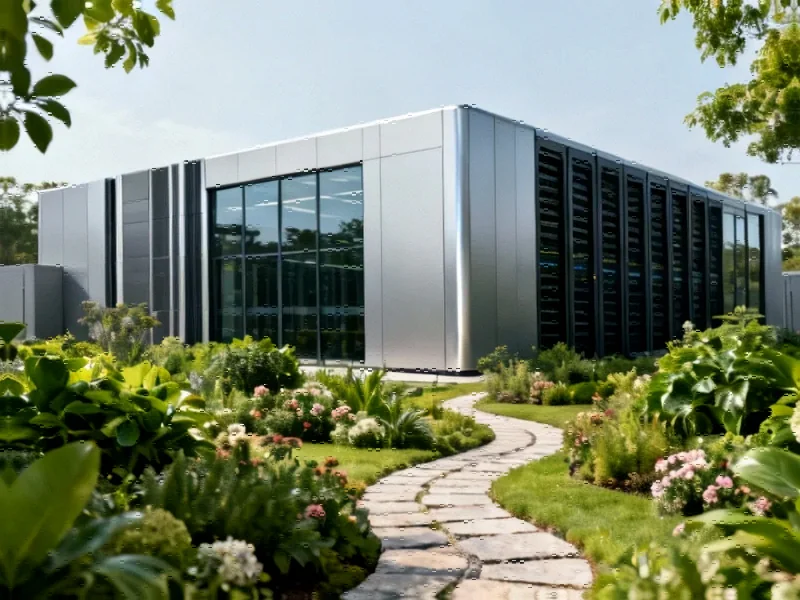The Great Energy Shift: From Oil Fields to Data Centers
In a remarkable strategic pivot, major fracking and oilfield services companies are racing to power the artificial intelligence revolution as their traditional business faces structural challenges. Liberty Energy, Halliburton, Baker Hughes, and other industry leaders are making massive investments in data center power generation, creating an unexpected synergy between fossil fuel infrastructure and cutting-edge technology.
Table of Contents
- The Great Energy Shift: From Oil Fields to Data Centers
- The AI Power Demand: “Like Nothing I’ve Ever Seen”
- Strategic Adaptation: From Fracking Fleets to Power Generation
- Technology and Infrastructure Solutions
- Political and Regulatory Challenges
- The Reliability Imperative
- Oil Industry Headwinds Persist
- Future Outlook: Recovery and Transformation
The movement gained significant momentum in October when Liberty Energy announced it would more than double its planned power generation capacity for data centers, causing its stock to surge 30%. Similarly, Halliburton revealed its 20% stake in VoltaGrid and plans to partner on powering data centers worldwide, driving its shares up approximately 15% this month.
The AI Power Demand: “Like Nothing I’ve Ever Seen”
The explosive growth in artificial intelligence has created unprecedented electricity demands that traditional power grids are struggling to meet. Halliburton chairman and CEO Jeff Miller captured the industry sentiment during an October earnings call, stating, “The demand for power and for AI is like nothing I’ve ever seen in terms of demand growth. We also know that, not only in the U.S., but around the world [AI] is a really big opportunity set for the same level of growth.”
This power push comes as drillers and fracking companies face a perfect storm of weak oil prices and declining activity despite record U.S. oil production. The industry has achieved remarkable efficiency gains, with the number of frac fleets required in the U.S. dropping more than 50% in six years even as production reached an all-time high of 13.6 million barrels per day.
Strategic Adaptation: From Fracking Fleets to Power Generation
Liberty Energy’s transformation exemplifies the broader industry trend. The company had already invested heavily in natural gas generator equipment to electrify its fracking services, and now it’s adapting its digiPower technology for data centers. According to CEO Ron Gusek, Liberty is increasing its power generation capacity from a planned 400 megawatts to more than 1 gigawatt through 2027 – enough electricity to power approximately 750,000 homes.
“My expectation is we probably end up with a higher percentage of our capacity with data center customers than maybe we had anticipated at the outset of our foray into this business,” Gusek noted during the company‘s October earnings call.
Technology and Infrastructure Solutions
The approach varies by company but centers around reliable, scalable power generation:
- Liberty and Halliburton are deploying versions of reciprocating natural gas generator sets lined up at data centers
- VoltaGrid (partially owned by Halliburton) just announced a deal with Oracle to deliver 2.3 gigawatts of power
- Baker Hughes, SLB, and Solaris are focusing on increasing gas turbine manufacturing for data centers
- Liberty has partnered with nuclear startup Oklo for future transition to small modular nuclear reactors
Political and Regulatory Challenges
In a surprising critique, Liberty CEO Ron Gusek directed criticism at the Trump administration’s tariff policies, particularly regarding steel and aluminum needed for power equipment. “The secretary of energy has called the race for AI dominance our next Manhattan Project,” Gusek said. “Winning this race requires access to massive amounts of new power generation capacity and associated hardware… Much of this is currently made overseas, and much of it is now subject to tariffs.”
He questioned whether this approach would lead to U.S. leadership in AI and energy, calling it “a path to mediocrity at best” and urging a policy pivot.
The Reliability Imperative
According to Tom Curran, energy technology analyst with Seaport Research Partners, the key to long-term success in powering data centers isn’t just capacity but consistency. “It’s one thing to go out and put together the capex and plow it into building a fleet of these assets and deliver them, set them up, and turn them on; it’s another thing to meet the standards of 24-7 power reliability,” Curran emphasized.
He described the power opportunity as “very real, it’s early, and it’s to be determined which sort of approaches and types of contracts prove to be the most competitive.”
Oil Industry Headwinds Persist
While the data center power business shows promise, the traditional oilfield services sector continues to struggle. Liberty posted third-quarter net income of $43 million, down 42% year on year, with quarterly revenues falling 17%. Halliburton’s net income plunged to a barely profitable $18 million from $571 million, although revenues only fell 2%.
Gusek noted that “oil and gas industry frac activity has now fallen below levels required to sustain North American oil production,” as producers moderate completions amid macroeconomic uncertainty after exceeding production targets earlier in the year.
Future Outlook: Recovery and Transformation
Industry executives express growing optimism that the global oil glut – exacerbated by ongoing OPEC production hikes – will peak in the first half of 2026, potentially allowing for recovery in the latter half of next year. Meanwhile, the pivot to data center power represents both a necessary adaptation and a significant growth opportunity., as earlier coverage
As Curran observed, “We’re finally reaching the end of what has been this long, remarkable, continued increase in U.S. oil production while we’ve had an ongoing contraction in U.S. oilfield activity. That’s been because of this really miraculous continued upturn in productivity. Well, that finally seems to be reaching its end. That means, even if they want to hold oil production flat, they’re going to have to start picking up activity next year.”
The convergence of energy and technology sectors continues to accelerate, with fracking companies positioned to play a crucial role in powering the next wave of technological innovation while navigating their traditional industry’s ongoing transformation.
Related Articles You May Find Interesting
- Rethinking Hybrid Work: Why Quarterly In-Person Collaboration Outshines Weekly O
- DataSnipper CEO Discusses AI Transformation in Auditing Industry on EU-Startups
- Helsinki’s Donut Lab Strengthens E-Mobility Ecosystem with Nordic Nano Partnersh
- Maximize Your Digital Security: 1Password Subscription Now Available at Industry
- Dutch Semiconductor Intervention Threatens European Auto Manufacturing Supply Ch
This article aggregates information from publicly available sources. All trademarks and copyrights belong to their respective owners.
Note: Featured image is for illustrative purposes only and does not represent any specific product, service, or entity mentioned in this article.



